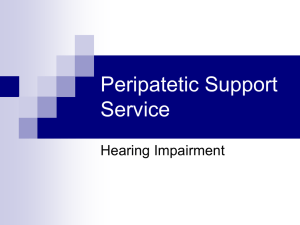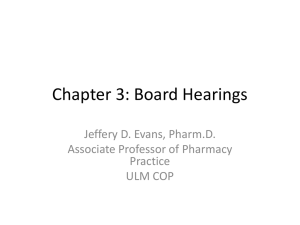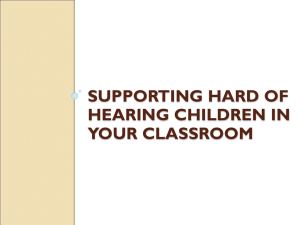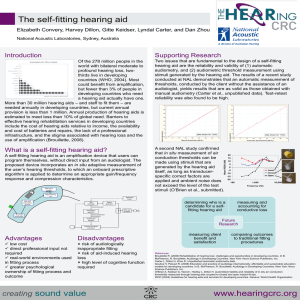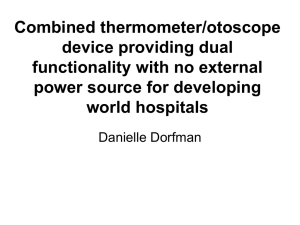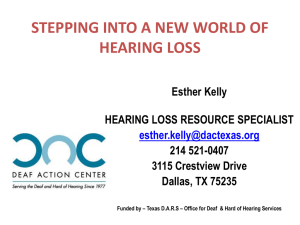Cox data: Average ratings for both sets of instruments for each
advertisement
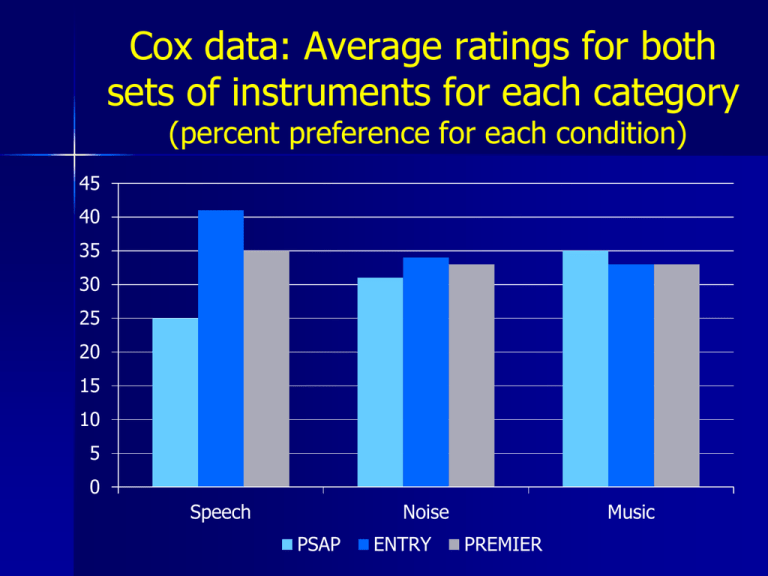
Cox data: Average ratings for both sets of instruments for each category (percent preference for each condition) 45 40 35 30 25 20 15 10 5 0 Speech Noise PSAP ENTRY Music PREMIER Clinical Tip From This Article? The differences among PSAPs, Entry Level and Premier hearing aids may not be as large as some people believe. Caveat 1: They were all fitted to NL2 targets. Caveat 2: These were laboratory measures. The first of the peer-reviewed studies from the Cox data: What they did . . . Compared examples of premium hearing • aids, to entry level hearing aids for two different leading manufacturers. Each device was fitted to NAL-NL2 targets. The participants used each pair of hearing aids for one month. Laboratory and real-world measures: Speech-in-noise testing completed at three different levels. Self-assessment scales: – APHAB – SSQ (SSQ-B) – DOSO Hearing Quality of Life Scale Patient Diary for everyday listening: Recording of both positive and negative experiences Mean audiograms for the two groups Comparison of the features of the different products Results for the objective speech-in-noise testing Overall results from the APHAB Overall averaged score for real-world speech understanding from the three self-assessment inventories Distribution of the “positive comments” from the Patient Diary, categorized by different general topics for the four different instruments (Note: Tall bars are good) Distribution of the “negative comments” from the Patient Diary, categorized by different general topics for the four different instruments (Note: Short bars are good) What about the “Quality of Life” findings? How much did hearing aid use improve “Hearing Quality of Life?” But again, no differences among products was observed Clinical Tip From This Article? Given the consistency of the laboratory results, and the different real-world measures, it would seem that at least for speech understanding, there is not a significant difference among the different “Tiers” of hearing aid products. Clinical Tip From This Article? Points made by the authors: If you look closely at the basic research on all these speical features, this finding would be more or less expected. This relationship will probably not change, as when a new “Top Tier” product is introduced (which may have enhanced features), the previous Top Tier product becomes “Entry Level,” so differences remain minimal among products. Let’s talk about “trainable” Data obtained with 3rd generation trainable hearing aids. (Palmer, AudiologyOnline, 2012) One of the purposes of the study was to examine the effects of the “start time” of the training. All participants were new hearing aid users (fitted to NALNL1): Control group (n=18) = training was off and then turned on at the second visit Experimental group (n=18) = training was on from the beginning Following training, comparisons made to the original NAL fitting, and comparative speech testing General findings regarding trained gain and real world loudness judgments • Gain for soft was reduced slightly for both groups, but somewhat more for the group who had trained from the beginning: Control: SII for soft speech reduced ~2% Experimental: SII for soft speech reduced ~4% • Real-world loudness judgments (PAL ratings): No difference from programmed to trained gain. No difference between groups. Training had no positive or negative effect on overall HINT performance for either group Preferences for trained gain versus original programmed gain (65% selected the trained gain; ) More research with trainable hearing aids (Research from the NAL) Real-life efficacy and reliability of training a hearing aid Keidser G, & Alamudi K Ear & Hearing, 2013, 34(5) What they did . . . Test devices enabled training of the compression characteristics in four frequency bands and in six sound classes Participants wore the devices programmed to NAL-NL2 for 3 weeks and trained the devices from the prescribed response for three weeks What they did . . . They compared their trained response with the prescription (NAL-NL2) The devices were reset to the prescription, and 19 participants repeated the training and comparison trials During the comparison trial, participants made daily diary ratings of satisfaction with the programs, and a structured interview was completed What they found . . . What they found . . . About half made insufficient changes and could not distinguish between the prescribed and trained responses For those who made sufficient changes, training was effective for 75 to 80% and tended to result in higher overall satisfaction with the devices Clinical Tip From These Articles? Not everyone is a good candidate for trainable hearing aids, but for those who are . . . Training appears to improve the overall fitting for the majority, and does not have any downside. Note: A peripheral finding (and clinical gold nugget) is that the NAL-NL2 is a pretty darn good starting point. If these two fellows had the same hearing loss, would you fit them with the same signal processing? Is there a hearing aid for the thinking person? Hafter, E. JAAA, 2010; 21:594-600 A discussion paper related to potential cognitive effects that can relate to performance using hearing aids The role of top-down processing in the success of amplification? What happens when two different patients, asked to respond to a change in a complex sound, do so on the basis of different stimulus features? The use of different listening strategies? The role of training? Example: Visual reaction time Speech-in-noise testing was conducted at varying SNRs. Testing was conducted with DNR-On and DNR-Off For the visual reaction measurement, (occurring concurrently with the speech recognition task) subjects were asked to quickly indentify a number as either odd or even. Visual reaction time task: Findings from visual reaction time study:


